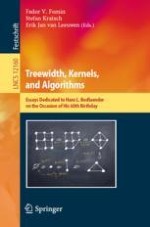2020 | Buch
Treewidth, Kernels, and Algorithms
Essays Dedicated to Hans L. Bodlaender on the Occasion of His 60th Birthday
herausgegeben von: Fedor V. Fomin, Stefan Kratsch, Erik Jan van Leeuwen
Verlag: Springer International Publishing
Buchreihe : Lecture Notes in Computer Science
